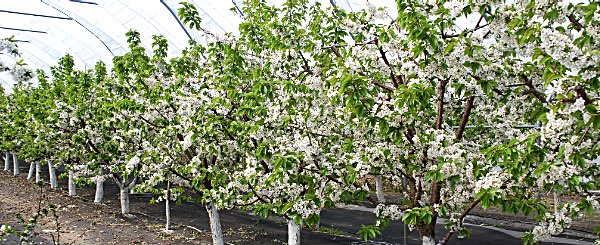- By Lindsey Hadlock
- Around Town
 Print
Print  Cherry trees bloom under the protection of a high tunnel. Photo by Greg Lang, University of Michigan
Cherry trees bloom under the protection of a high tunnel. Photo by Greg Lang, University of MichiganCherry producers in New York state and the Great Lakes region don't have it easy. They face extreme temperatures in the winter, and in the summer, excessive rain can ruin the fruit. But if they can manage to avoid those risks, they stand to cash in: Cherries are one of the most profitable fruit crops, and there's a growing demand in the Eastern U.S. for locally grown cherries.
Several long-term strategies can mitigate growers' financial risks, from crop insurance to weather insurance to high tunnels – tall temporary greenhouses that extend up and over the cherry trees and protect them with plastic sheeting or netting.
But not much is known about which strategy offers the biggest bang for the fruit growers' buck.
New Cornell University research offers growers guidance – and potentially significantly higher profits.
Cherry growers looking to mitigate weather risks could double their long-term net return per acre by using high tunnels, according to the study, for two reasons. Trees grown in high tunnels tend to produce bigger fruit, and that fruit matures faster than it would if it were grown in an open field.
That means higher quality cherries available earlier in the season. While other growers are still waiting for their fruit to ripen, growers using high tunnels are already picking and selling cherries at a premium price, the researchers said.
"Growing high-value fruits in a protected environment could be the future for New York growers," said co-author Bradley Rickard, professor in applied economics and management. "Normally we don't think of growing fruit crops in a greenhouse. We're saying it's definitely possible to do it, and it might even make economic sense to do it."
Added lead author and doctoral candidate Shuay-Tsyr Ho: "We're thinking of it long term, so you invest and then it pays off after 15 to 20 years. And these tunnels could be applicable to other high-value fruit crops that also have significant weather risk."
The study, "Alternative Strategies to Manage Weather Risk in Perennial Fruit Crop Production," is published online in Agricultural and Resources Economics Review. Ho and Rickard's co-authors are Jennifer Ifft, assistant professor of applied economics and management, and Calum Turvey, professor of agricultural finance.
The study was supported by the U.S. Department of Agriculture.
v14i28



